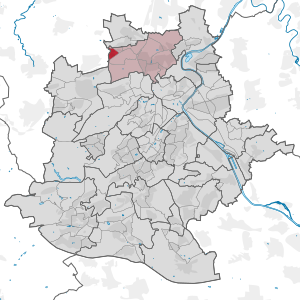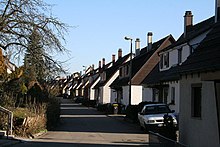Neuwirtshaus (Stuttgart)
|
Neuwirtshaus district of Stuttgart |
|
|---|---|
| Coordinates | 48 ° 50 ′ 15 " N , 9 ° 8 ′ 40" E |
| surface | 0.362 km² |
| Residents | 824 (May 31, 202) |
| Population density | 2276 inhabitants / km² |
| Incorporation | Apr 1, 1931 |
| Post Code | 70439 |
| prefix | 0711 |
| Borough | Zuffenhausen |
| Source: Data Compass Stuttgart (PDF) | |
Neuwirtshaus is a district on the northwestern edge of the Baden-Württemberg state capital Stuttgart . It belongs to the Zuffenhausen district , is 36.2 hectares in size and is located between Korntal and Stammheim . Neuwirtshaus connects to the northwest of the Zuffenhausen industrial area, where the headquarters of Porsche AG and the Neuwirtshaus (Porscheplatz) train stop, which opened in 1937, are located.
history
The name of the district "Neuwirtshaus" is derived from "Neues Wirtshaus". The name “Neues Wirtshaus” was mentioned for the first time in 1621; previously the building was called “Herberge an der Elbenstraße”. Elbenstraße already existed in the 1st century as Römerstraße and was similar to today's Schwieberdinger Straße. In the "hostel on the same street" found carters quarters for themselves and their horses. After the Thirty Years' War , the barons had to sell the manor Stammheim to the House of Württemberg . For a long time it was then a base for carriages of all kinds. From 1857 onwards, sugar beets were grown on what was then the "Gut Neuwirtshaus". In 1858, the Hofdomänenkammer leased the building and the land for the extension to the Stuttgart sugar manufacturer Adolf Reihlen. Until 1934 the estate was used for growing sugar beet and went through many tenants. The new inn was restored to its original purpose in 1934 by the Locher family and set up as an inn . There was a ballroom with 80 seats and inns in the house as well as seven chestnut trees around the house to provide shade. In 1990 the old Neuwirtshaus, which gave the district its name, was demolished after it had been damaged by fire and had stood empty for a long time. The style of the new building was modeled on the old Neuwirtshaus and is now used as a hotel and restaurant.
The so-called Neuwirtshaussiedlung still consists almost exclusively of formerly very similar semi-detached houses (brick - lined half-timbered houses ) with simple to medium-sized furnishings according to today's standard, which were built between 1933 and 1937. The former domain Neuwirtshaus of the House of Württemberg comprised around 7.5 hectares when it was built and consisted of 306 settler sites. The developer was the Stuttgarter Siedlungsgesellschaft mbH (SSG), founded in 1933, today SWSG (Stuttgarter Wohnungs- und Städtebaugesellschaft), which had set itself the goal of coping with mass unemployment "on community-owned garden land on the outskirts of the city to build small houses with stables and the unemployed to offer there with their families at the same time a home, a livelihood and a beneficial activity by u. a. left the management of a settler's site for a low rent or lease. ”The land was therefore leased to the settlers according to the principle of heritable building rights , so that residents with little equity could also afford a settler's house.
On April 1, 1931, Zuffenhausen (including the Neuwirtshaus and the area of the later Rotweg settlement ) was incorporated into Stuttgart. In 1961 Neuwirtshaus received the status of a district of Zuffenhausen.
Infrastructure
Neuwirtshaus has a primary school (built 1934–35 by architect Heintel Wilhelm) and a municipal day-care center. The focus is on the cultural monument of the Evangelical Michael Church , which was built in Scandinavian style in 1938 by Professor Paul Heim, a student of Paul Bonatz . Because of the impending war, it was given a reinforced concrete ceiling and, not least because of its half-timbered construction, fits in with the other settlement houses. In 1940-41, a so-called “air raid shelter” was built right next to the church, a bunker with a cellar, which is also a cultural monument and has 730 spaces.
In addition to the semi-detached houses with their relatively large properties, allotment gardens and the edge of the Seewald characterize the image of Neuwirtshaus.
The Neuwirtshaus e. V. represents the interests of the residents.
population
In 2007, 855 people lived in the Neuwirtshaus. In 2006, Neuwirtshaus had significantly low values in comparison to the Zuffenhausen district with the proportion of foreigners of only 4% (Zuffenhausen 2005: 27%) and a proportion of single-person households of only 28% (Zuffenhausen 45%). At 5.0%, the unemployment rate was well below that of the city of Stuttgart (13.6%) and the Zuffenhausen district (15.7%). Due to the relatively high proportion of older residents (average age 2005: Stuttgart: 41.7 years, Zuffenhausen: 41.3, Neuwirtshaus: 45.9), the number of residents in Neuwirtshaus sank comparatively significantly until a few years ago.
| year | Inhabitants of the Neuwirtshaus |
|---|---|
| 1935 | 1462 |
| 1980 | 1079 |
| 1990 | 912 |
| 1993 | 826 |
| 2005 | 870 |
| 2007 | 855 |
traffic
Neuwirtshaus is located on federal highway 10 and near the Stuttgart-Zuffenhausen junction of federal highway 81 .
The S 6 (Weil der Stadt – Stuttgart-Schwabstraße) and S 60 (Böblingen – Renningen – Stuttgart-Schwabstraße) of the Stuttgart S-Bahn stop at Neuwirtshaus (Porscheplatz) station . Operation of the stop by the Strohgäubahn was discontinued in 2012 and should resume after completion of Stuttgart 21 if necessary .
Buses run by the Stuttgart trams (SSB) and the Württembergische Eisenbahn-Gesellschaft (WEG). The bus lines 52, 90 and 612 connect the stop Borkumstraße / Neuwirtshaussiedlung with Zuffenhausen , Bad Cannstatt , Korntal , Münchingen and in the evening also with Stammheim .
Web links
Individual evidence
- ↑ a b c data compass city districts Stuttgart 2007/2008 - city district profile 23 Zuffenhausen (PDF; 1.8 MB)
- ↑ Deutsche Reichsbahn - change of station names in 1937 ( page no longer available , search in web archives ) Info: The link was automatically marked as defective. Please check the link according to the instructions and then remove this notice.
- ↑ Handwritten chronicle by Hirschwirt Bader (copy in the Stuttgart City Archives) p. 134
- ^ Description of the Oberamt Ludwigsburg, printed in 1859, p. 329
- ↑ Nordstuttgarter Rundschau of July 18, 1978
- ↑ Stuttgarter Wohnungs- und Städtebaugesellschaft mbH - Annual Report 2003 ( Memento of the original from April 19, 2009 in the Internet Archive ) Info: The archive link was inserted automatically and has not yet been checked. Please check the original and archive link according to the instructions and then remove this notice. (PDF; 3.0 MB)
- ↑ Thomas Schwarz: The spatial division of Stuttgart into districts and districts. State capital Stuttgart 1/2004 (PDF; 665 kB)
- ↑ a b State capital Stuttgart - List of cultural monuments - City district of Zuffenhausen ( page no longer available , search in web archives ) Info: The link was automatically marked as defective. Please check the link according to the instructions and then remove this notice.
- ↑ Schutzbauten Stuttgart - Hochbunker Neuwirtshaus ( Memento of the original from February 9th, 2009 in the Internet Archive ) Info: The archive link was automatically inserted and not yet checked. Please check the original and archive link according to the instructions and then remove this notice.
- ^ Britta Klagge: Poverty in West German Cities
- ↑ a b State capital Stuttgart - population statistics (PDF; 830 kB)
- ↑ a b c State capital Stuttgart - Statistical Office - data compass city districts Stuttgart (PDF; 2.7 MB)
- ↑ Urban planning forum Stuttgart e. V. - Zuffenhausen ( Memento of the original dated December 23, 2008 in the Internet Archive ) Info: The archive link was inserted automatically and has not yet been checked. Please check the original and archive link according to the instructions and then remove this notice.



